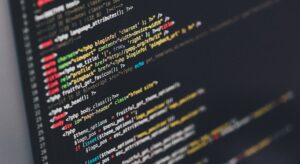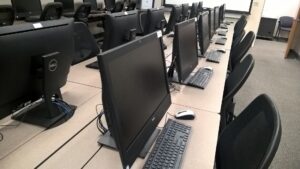
AI in Education: From Peril to Promise
Pam Sornson, JD
April 16, 2024
One unexpected benefit arising out of the COVID-19 pandemic is the global embrace of technology to further goals and improve systems. During its acute phase – after the identification of the coronavirus and before comprehensive vaccination strategies reduced its lethality – many businesses and even whole industries adapted their internal processes and external outreach to accommodate responsive digital resources. The world’s education systems were leaders in these endeavors, and many schools were able to maintain (although not fully match or achieve) presumed educational trajectories despite the virus’s many interruptions and disruptions.
To a certain extent, the uncomfortable experience of transitioning from classroom to computer teaching and learning introduced many teachers, students, and institutions to the values and benefits of digital educational tools. The new ‘digitally enhanced’ educational processes offered ways to improve courses and programs while also giving learners more tools with which to – well – learn.
As Artificial Intelligence (AI) technology gains ever more educational territory as a valued asset for both sides of the teaching process, each can benefit from its expansive capacities, just as they did as they transitioned from a campus-based educational platform to a virtual or hybrid one.

From Chaos to Creativity
While it seems that AI has just recently burst onto the global stage, it’s actually been working behind the scenes for many years. However, the more recent advent of Generative AI as a consumer-directed tool has stirred a global frenzy, as programs like ChatGPT offer their users unique and never-before-seen production and creativity options.
The higher education community has been particularly interested in AI, looking at how it can enhance their efforts and those of their students and stakeholders. They’re also very cognizant of the potential threat the programming presents to their systems and tried-and-true practices. Accordingly, schools across the country have been evaluating the presence of AI on their campuses and making decisions based on how it’s currently deployed and how they can better master its resources going forward.

Early Adoptions
According to a 2023 survey by EDUCAUSE, a non-profit organization dedicated to evaluating the use of data and technology to ‘further the promise of higher education,’ the higher ed community is now busy exploring how the technology is used, can be used, and should be used. Survey responses indicate that while most schools (76%) are tuning their current AI efforts to improve the student experience, many are also exploring how to implement AI capacities into other educational processes.
As a Strategic Planning Tool:
As a strategic planning tool, AI is now almost ubiquitous on higher ed campuses, with a full 89% reporting that their institution is actively using it to plan its next steps. Schools are concerned about maintaining an ‘AI status quo’ with their students who have already adopted the technology. They’re also unnerved by the potential for inappropriate use that practice might entail. They do, however, embrace it as a strong supplement to their student services capacities. Many have already begun operationalization of AI goals by implementing training classes for faculty (56%), staff (49%), and students (39%).
As a Leadership Tool:
In general, most higher ed leaders’ opinions about AI mirror those of the general public; they are ‘cautiously optimistic’ about its successful implementation as a school-wide asset. More than half (56%) are now actively engaging with AI within their roles, and most believe that almost all functional elements of their administrations have or will have responsibilities to adopt and manage AI strategies within their sectors.
Survey responses also indicate more work needs to be done. Many leaders report being unaware of what others are doing regarding AI adoption, both on their campus and around their region. Institutional silos may be the cause of the gaps.
As an Impact on the Institution:
Almost across the board, AI processing is changing how schools go about their business:
Teaching:
Almost all respondents (95%) reported that AI is already having a notable impact on teaching and learning, indicating that both instructors and students are seeing evidence of the technology in many of their classroom activities.
More than three in four (78%) respondents acknowledged that technology ‘has impacted academic integrity.‘ Teachers have begun questioning whether some of the work submitted by their students is authentic and original because the text does not conform to the learner’s typical writing style and proficiency.

Continuing Concerns
Schools are also recognizing and experiencing the challenges AI presents, especially regarding information security.
Four in five (79%) respondents are concerned about the impact of AI on cybersecurity systems, while 72% see its threat to data privacy.
Three in four (74%) are concerned that inappropriate AI usage may violate federal regulatory compliance, while more than half (56%) share similar concerns regarding local compliances and ethical data governance practices.
More than half (52%) report concerns about AI and its capacity to amplify the embedded biases that exist in current databases.
Many also reported the misuse of the technology, noting papers submitted that clearly hadn’t had human oversight in their creation and had not disclosed their AI origin or resource.
Overall, the survey reveals that AI is swiftly entering the higher education sector as both a supportive tool (for teaching, learning, and strategy) and a threat (impacting data privacy, integrity, and security). Responses present a mixed picture of its impact on higher education institutions. Gains are being made in school productivity and student connections, while concerns remain regarding the technology’s capacity to erode academic integrity and information, institutional, and personal security systems. And notably, despite its growing presence on campus, only a few respondents (11%) had seen new AI-related jobs emerge or existing jobs be modified (14%) to reflect the technological advances.
Just as the pandemic rolled unimpeded over the world, AI is spreading – mostly uncontrolled – into all corners of society. Like all industries, the higher education sector must also expend the resources needed to harness its promise and quell its threat if it wants the technology to enhance its future and that of its stakeholders.


